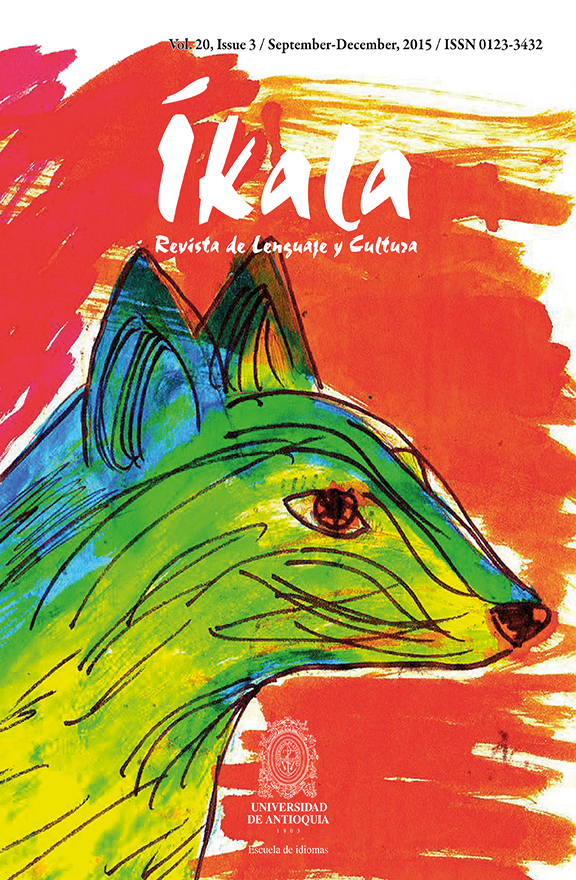Evaluación del Contexto de un Programa de Competencia Lectora en Inglés en una Universidad Pública en Colombia a través del Modelo de Evaluación CIPP.
DOI:
https://doi.org/10.17533/udea.ikala.v20n3a02Palabras clave:
evaluacion de programa, modelo de evaluacion CIPP, politica de lengua extranjeraResumen
Este articulo presenta los resultados de la evaluacion de contexto del programa de competencia lectora de la Universidad de Antioquia. Para llevar a cabo esta evaluacion, se utilizo el modelo CIPP (contexto, insumo, proceso, producto) propuesto por Daniel Stufflebeam (1983, 1993, 2000), y se enmarco dentro de una investigacion de corte mixto. La recoleccion de datos cualitativos y cuantitativos se hizo a partir de metodos tales como cuestionarios, grupos focales, y entrevistas y fue obtenida de estudiantes, profesores, y administradores del mismo programa como de la universidad. El analisis de los datos se hizo por medio del programa libre R y el programa de analisis cualitativo NVivo 9. Los resultados de la evaluacion indicaron un estado global del programa, sus fortalezas, debilidades que se constituyeron en el aspecto mas sobresaliente; necesidades y posibilidades que dieron como efecto la recomendacion de acciones determinantes para una restructuracion del programa; y la politica de lengua extranjera en toda la universidad.
Descargas
Citas
Bausela Herreras, E. (2003). Metodología de la investigación evaluativa: modelo CIPP. Revista Complutense de Educación, 14(2), 361–376.
Brown James D. (1995). Language program evaluation: decisions: problems and solutions. Annual Review of Applied Linguistics, 15, 227–248.
Consejo Nacional de Acreditación. (2003). Lineamientos para la acreditación de programas. Bogotá: CNA.
Consejo Nacional de Acreditación. (1998). La evaluación externa en el contexto de la acreditación en Colombia. Bogotá, CNA.
Correa Uribe, S., Puerta Zapata, A. & Restrepo Gómez, B. (1996). Investigación evaluativa. Bogotá: Instituto Colombiano para el Fomento de la Educación Superior, ICFES. Recuperado de http://web.unap.edu.pe/web/sites/default/files/Investigacionevaluativa.pdf
Johnson, B., & Christensen, L. (2008). Educational research: Quantitative, qualitative, and mixed approaches (3rd. ed.). Los Angeles: Sage Publications.
Johnson, R. B., & Onwuegbuzie, A. J. (2004). Mixed methods research: a research paradigm whose time has come. Educational Researcher, 33(7), 14–26.
Johnson, R., Onwuegbuzie, A. J., & Turner, L. A. (2007). Toward a definition of mixed methods research. Journal of Mixed Methods Research, 1(2), 112–133.
Jung, S. K. & Norton, B. (2002). Language planning in Korea: The new elementary English program. En J. W. Tollefson (ed.), Language policies in education: Critical issues (pp. 245–266). Mahwah, NJ: Lawrence Erlbaum Associates.
Kiely, R. & Rea–Dickins P. (2005). Program Evaluation in Language Education. Hampshire: Palgrave MacMillan.
Mora Vargas, A. I. (2004). La evaluación educativa: concepto, periodos y modelos. Actualidades Investigativas en Educación, 4(2), 1–28.
Pérez Juste, R. (1993). Evaluación de programas sociales. Documento policopiado.
Ruiz, J. (2004). Cómo hacer una evaluación de centros educativos. España: Narcea.
Stufflebeam, D.L. (1983). The CIPP model for evaluation. En G.F Madaus. M. Scriven, & D.L. Stufflebeam (eds.). Evaluation Models (pp. 117–141). Norwell, M.A: Kluwer
Stufflebeam, D. L. (2000). The CIPP model for evaluation. En D.L Stufflebeam, G. F. Madaus y T. Kellaghan (eds.), Evaluation models (2nd. ed.), (pp. 279–317). Norwell, MA: Kluwer.
Stufflebeam, D.L. (2003). The CIPP model for evaluation. En T. Kellaghan (ed.). International handbook of educational evaluation. Dordrecht: Kluwer Academic.
Stufflebeam, D. L. y Shinkfield, A. J. (1993). Evaluación sistemática. España: Paidós,
Stufflebeam, D., & Shinkfield, A. (2007). Evaluation theory, models, and applications. San Francisco: Jossey–Bass.
Tashakkori, A., & Teddlie, C. (eds.). (2003). Handbook of mixed methods in social & behavioral research. Thousand Oaks, CA: Sage.
Urbano Canal, N. (2007, julio–diciembre). Efectos de la implementación del modelo colombiano de acreditación de programas académicos. Un análisis a partir del caso de programas tecnológicos. Universitas Humanística, (64), 139–161.
Descargas
Publicado
Cómo citar
Número
Sección
Licencia
Derechos de autor 2015 Íkala

Esta obra está bajo una licencia internacional Creative Commons Atribución-NoComercial-CompartirIgual 4.0.












